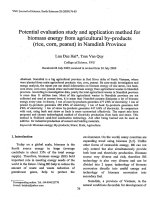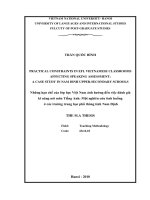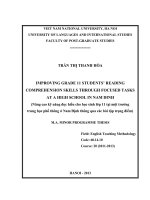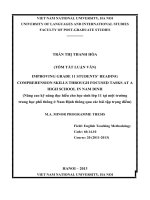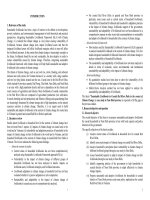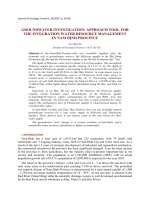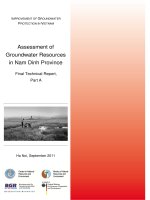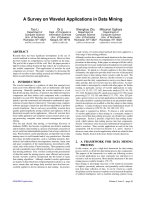Initial survey on microplastic waste in coastal water in Nam Dinh
Bạn đang xem bản rút gọn của tài liệu. Xem và tải ngay bản đầy đủ của tài liệu tại đây (723.76 KB, 8 trang )
Vietnam Journal of Marine Science and Technology 2022, 22(2) 209–216
Vietnam Academy of Science and Technology
Vietnam Journal of Marine Science and Technology
journal homepage: vjs.ac.vn/index.php/jmst
Initial survey on microplastic waste in coastal water in Nam Dinh
Phuong Ngoc Nam1,*, Pham Quoc Tuan1, Ngo Thi Xuan Thinh1, Nguyen Thi Minh Diep1,
Duong Thi Thuy2, Le Thi Phuong Quynh3, Le Nhu Da3, Phuong Ngoc Anh4,
Duong Thanh Nghi5, Le Quy Thuong6
1
PhuTho college of Medicine and Pharmacy, Phu Tho, Vietnam
Institute of Environmental Technology, VAST, Vietnam
3
Institute of Natural Products Chemistry, VAST, Vietnam
4
National Lung Hospital, Hanoi, Vietnam
5
Institute of Marine Resources and Environment, VAST, Vietnam
6
Phu Tho Genral Hospital, Phu Tho, Vietnam
*
E-mail:
2
Received: 13 September 2021; Accepted: 10 March 2022
ABSTRACT
Plastic materials are defined as including the whole of organic polymers owning plasticity. Their
production increases rapidly due to their superior properties and applications in our life. Currently, the
annual production of plastic is estimated at nearly 400 million tons. About 10% of the plastic produced is
discharged into the seas and oceans. Microplastics (MP, less than 5 mm in size) are non-biodegradable and
persistent in the environment and have the ability to accumulate in various environmental components,
organisms and other human beings through the food chain. Therefore, assessing microplastic pollution
becomes essential for the marine and ocean environment. This study aims to evaluate microplastic
pollution in Nam Dinh seawater. Water samples were taken in summer 2020 and spring 2021 in Giao Thuy
district, Nam Dinh province. Samples were treated with 30% H2O2 solution to remove organic matters and
then microplastic buoyantly separated using saturated NaCl solution. MP was identified through
observation under a stereo microscope (Olympus SZX2-TR300) and its nature was determined through
infrared spectroscopy (µFTIR). Results show that a large level of pollution (average 6 to 8 particles/m3 and
10–14 million particles/km2) is associated with the predominant of colored fibers among MP
characteristics. Most of the microplastics identified are Polypropylene in nature. Next, more research needs
to be invested in this pollution problem, such as expanding the scope and research object.
Keywords: Microplastic, marine pollution, seawater, infrared spectroscopy, Polypropylene.
Citation: Phuong Ngoc Nam, Pham Quoc Tuan, Ngo Thi Xuan Thinh, Nguyen Thi Minh Diep, Duong Thi Thuy, Le
Thi Phuong Quynh, Le Nhu Da, Phuong Ngoc Anh, Duong Thanh Nghi, and Le Quy Thuong, 2022. Initial survey on
microplastic waste in coastal water in Nam Dinh. Vietnam Journal of Marine Science and Technology, 22(2), 209–216.
/>ISSN 1859-3097/© 2022 Vietnam Academy of Science and Technology (VAST)
209
Phuong Ngoc Nam et al./Vietnam Journal of Marine Science and Technology 2022, 22(2) 209–216
INTRODUCTION
Humans have used natural polymers as
materials such as rubber since the beginning of
the 16th century. The introduction of synthetic
organic polymers (plastics) only appeared in
the early years of the 20th century. The demand
for plastic materials increases rapidly because
of outstanding properties such as lightness, ease
of molding, bending, water resistance, chemical
resistance, and durability. As the demand rises,
plastic production has increased more than 200
times in just 70 years, from 1.5 million tons in
the 1950s [1] to over 300 million tons in 2020
[2]. Recent estimates put the total number of
plastics produced at more than 8 billion tons
[3]. Only 9% are reused, and nearly 80% are
discharged into the environment. Many types of
plastic are used once, such as drinking cups,
food containers, and packaging, before being
directly released, which is very harmful to the
natural environment [4]. Jambeck et al., (2015)
estimated that about 11% (275 million tons) of
plastic waste is generated by the population of
192 countries, most of which belong to China
and Southeast Asian countries. We estimate
that in 2010, 4.8 to 12.7 million tons of plastic
waste were discharged into the oceans, and by
2025 this number will increase to 250 million
tons [5]. In the natural environment, large
pieces of plastic over time will break into small
pieces as microplastics (from 1 µm to 5 mm)
under the influence of physico-chemicalbiological agents [6], making the primary
source of microplastics besides microplastic
particles/fragments used directly in products
such as toothpaste and cosmetics. With the
small size, microplastics can spread widely in
water and air, accumulating in sediments as
well as in the body of organisms and humans
[7]. Several recent studies have shown the
harmful effects of microplastics on organisms
as well as humans [8]. Environmental pollution
in general and plastic waste pollution is a
global hot issues. In Vietnam, in recent years,
rapid urbanization, population growth, and
strong development in agricultural and
industrial production have been affecting water
pollution and problems of plastic waste and
microplastics. As one of the most countries
discharging plastic waste into the ocean in the
210
world, research on plastic pollution in general
and microplastic pollution in particular in
Vietnam is still limited. Therefore, the
objectives of this study are: (i) to assess the
level of microplastic pollution in the coastal
water in Nam Dinh, an abundance of activities
such as tourism and aquaculture location, (ii) to
analyze the characteristics of pollution, trace
pollution sources and (iii) compare pollution
levels with other studies in the world as well as
propose research directions in the future.
MATERIALS AND METHODS
Sampling
Seawater was sampled in Giao Thuy
district, Nam Dinh province (July 2020 and
January 2021, Figure 1). Samples were taken at
2 locations at high tide according to standard
methods (manta net with a diameter of 50 cm,
mesh size of 80 µm, time of 60 seconds, speed
of 5 km.h-1). At each location, seawater is
collected from 3 points at least 50 m apart.
Information such as pH, salinity, temperature,
and wind speed was measured in detail at the
sampling time (Table 1). The sample was
recovered (water in the beaker) with pure water
in a clean glass vessel, pooling 3 points into a
glass flask (1 liter). Seal, label, and store cool
during transport to the laboratory, where
samples are stored at -20ºC until analysis. A
total of 4 seawater samples were studied.
Sample processing
MP analysis in seawater samples was
applied according to current procedures [8].
After 2–4 hours of thawing, the water sample
was left in the beaker. At each study site, 5
replicates were performed. Biological tissue
residues will hinder the observation and
identification of microplastics. Therefore, they
were digested with 30% H2O2 solution (purity
> 99%, Xilong Scientific, China). Hydrogen
peroxide was added several times, little by
little, and gently heated at 40ºC until no visible
biological tissue residue remained. Microplastic
floatation step will be applied through the use
of saturated NaCl solution (Shanghai Zhanyun
Chemical, China) (density 1.2 mL-1). The
microplastics in the sample are separated
through a filtration step (0.7 µm fiberglass
membrane, Whatman). The filter membrane
Phuong Ngoc Nam et al./Vietnam Journal of Marine Science and Technology 2022, 22(2) 209–216
will be dried under normal conditions and
stored tightly closed until MP is analyzed.
Sample analysis
Dried membrane filter will be observed
under a stereo microscope (Olympus SZX2TR300, 300x magnification). Acceptance
criteria for microplastics for observed objects
are as suggested by Nor and Obbard [9]. For
example, the observed object does not have
organic structures; the color is uniform on the
entire object’s surface. Observation is carried
out by at least 2 experienced and independent
experts. Observation results of each person will
be aggregated with complete information such
as position (value of two axes OX and OY),
color, shape, and size (maximum, minimum).
Microplastics are accepted as observed by both
experts. The nature of microplastics and some
particles/fibers were examined by measuring
infrared
spectroscopy
(µFTIR_Thermo_Nicolet_iZ10).
Each
measurement using the transmittance method
was made with 8 accumulations over the
wavelength range 4,000 cm-1 to 1,300 cm-1.
Reference spectral data and acceptance criteria
for the measured spectrum were used through
the siMPle software. All experiments were
performed in a clean laboratory, in a bottle
cabinet, tightly sealed with aluminum foil as
much as possible to ensure analytical quality.
The requirements for gloves and blouses are
strictly guaranteed. The analysis blank using
double distilled water of the same volume as
the sample was carried out parallel to the
seawater sample. Analytical results are
corrected with blank samples, and the
microplastic concentration unit is calculated
according to the number of microplastics
(mean,
standard
deviation)
by
area
(microplastics per km2) and volume
(microplastics in m3) of seawater sampled.
(B)
(A)
Figure 1. Sampling location of seawater (A) and sampling method (B) in Nam Dinh
(illustration for S1 location in July 2020)
Table 1. Environmental parameters of Nam Dinh seawater in the study area at the time of sampling
Parameters (average ± standard deviation, N = 3)
Value
pH
Temperature (ºC)
Salinity (%)
Wind (km.h-1)
6.91 ± 0.06
27.10 ± 0.17
3.02 ± 0.12
6.70 ± 0.35
RESULTS AND DISCUSSIONS
MP concentration
Figure 2 shows that the average
concentration of microplastics in seawater in
Nam Dinh was recorded in the range of 10.6–
14.4
million
microplastics/km2
(6.7–
9.2 microplastics/m3). The two study sites
differed by distance from the coastline. The
results show that there is not enough to
difference significative between these two
locations (p > 0.05) even though the location
S2 is taken at the exit area of the sluice gate.
Meanwhile, seawater samples in spring seem
to be higher than those taken in summer.
211
Phuong Ngoc Nam et al./Vietnam Journal of Marine Science and Technology 2022, 22(2) 209–216
Figure 2. MP concentration in seawater in Nam Dinh at different locations and seasons,
calculated by volume (A) and surface (B)
This result is higher than some reports of
seawater microplastics in in international
publications (Table 2). The results’ variability
reflects the microplastic contamination level at
different study sites. However, part of this
disparity also comes down to research
objectives, such as some studies focusing only
on 1–5 mm subjects. Moreover, the
concentration of microplastics also depends on
the sampling method, separation method, and
microplastic identification technique. For water
samples, most studies used mesh sizes at the
limit of 330 µm or 500 µm, while we used 80
µm mesh with the goal of maximum
microplastic recovery. In addition, the method
of determining microplastics also plays a vital
role in influencing the reported results. There is
a risk to observation in accepting microplastics.
However, it is noteworthy that this method is
still dominant in most of the studies (> 70%) in
the world [10]. This study used two
independent and empirical observations to limit
risk. Note that the success rate in observation is
sometimes only 6% [11].
MP characteristics
Characteristics of MP analyzed in seawater
in Nam Dinh presented in Figure 3.
Figure 3. MP characteristics in seawater in Nam Dinh, form (A), color (B) and Size (C)
212
Phuong Ngoc Nam et al./Vietnam Journal of Marine Science and Technology 2022, 22(2) 209–216
In this study, microplastic sizes were
recorded from 20 µm to 2 mm, dominated by
sizes smaller than 300 µm, despite being
collected with an 80 µm mesh. The samples are
smaller than 100 µm due to agglomeration
properties. This study’s predominance of
microplastics smaller than 300 µm is also the
main reason for the difference in Table 2.
Besides the microplastic size factor, the
difference in the time and location of study
sampling also influenced the differences
between studies in Table 2.
Table 2. Comparison of MP concentration in seawater in Nam Dinh with others studies in the world
Continent
America
Asia
Australia
Europe
Asia
Location
Atlantic (Northwest)
Atlantic (North)
Caribe Sea
Pacific (North)
Pacific (West)
Australia
Mediterranean Sea
Nam Dinh (Vietnam)
Time
1972
1986–2008
1987–1988
2000–2001
2013
2020–2021
Fiber-typed microplastics are dominated
among the shape textures, similar to those
reported by Lahens et al. (2017) performed in
water samples in the Saigon river [18]. When
observing the analytical blank, some objects
appear on the filter membrane. However, they
are distinct from the microplastic matters in the
Concentration
3,500 MP/km2
1,534 MP/km2
1,414 MP/km2
389,800 MP/km2
174,000 MP/km2
4,000–9,000 MP/km2
243,853 MP/km2
10.6–14.4 million MP/km2
Size (µ)
250–500
> 335
53-1000
> 330
> 333
> 200
> 20
Reference
[12]
[13]
[13]
[14]
[15]
[16]
[17]
This study
real sample (Figure 4). Most microplastics have
prominent colors (blue, purple, red). The
characteristics
of
microplastics
allow
identifying the origin of microplastics in
seawater in Nam Dinh, most likely from
artificial fibers, such as domestic waste
(washing machines) or the textile industry.
Figure 4. MPs observed under a stereo microscope, red border indicates MP position and size
Among the identified particles/fibers,
Polypropylene plastic accounts for nearly 70%,
followed by Polyethylene (10%). This result is
similar to the production output of all plastics,
especially PE and PP because they are widely
used and have a short usage time. Besides two
other types of plastic were also identified,
including Polystyrene and Polyester (Figure 5).
The coastal zone plays a vital role in the
economic structure of Vietnam, in which the
aquaculture industry stands out. Microplastic
pollution in fish and bivalve mollusc farming
areas can potentially affect consumer health.
Research in Belgium in 2014 showed that
each adult could get up to 11,000 microplastic
particles per year through eating oysters and
mussels [19]. While the impact of
microplastics on human health remains
unproven, the risk factors for exposure to this
type of pollution are increasingly apparent.
213
Phuong Ngoc Nam et al./Vietnam Journal of Marine Science and Technology 2022, 22(2) 209–216
The contamination of microplastics is not only
through the consumption of seafood but also
in daily breathing, salt, and drinking water.
Recent research indicates that the human body
can infect 73 thousand, 4.7 thousand, and
30 million microplastic particles annually
through salt, drinking water, and air,
respectively [20].
Figure 5. Infrared spectra of 4 types of microplastics in seawater samples in Nam Dinh by
transmittance measurement (yellow is the measured spectrum, blue is the reference spectrum)
CONCLUSION
The results obtained in this study indicate a
high level of microplastic pollution in the
coastal water in Nam Dinh, Vietnam. This
report is one of the first data on microplastic
contamination in Vietnam. Microplastics
concentration was recorded at 10 million
microplastics
per
km2,
mainly fiber
microplastics. Most microplastics are less than
100 µm in size. Plastic is mostly PE and PP
(approximately 80%). Microplastics are
believed to come mainly from human activities,
such as textiles or domestic wastewater.
However, it is necessary to do more and more
deeply soon, in which determining the nature of
microplastics to specify their origin is an urgent
requirement.
Acknowledgements: This study is funded by
Vietnam National Foundation for Science and
214
Technology Development (NAFOSTED) under
grant number 105.08-2019.337.
REFERENCES
[1] Thompson, R. C., Moore, C. J., Vom
Saal, F. S., and Swan, S. H., 2009.
Plastics, the environment and human
health: current consensus and future
trends. Philosophical transactions of the
royal society B: biological sciences,
364(1526), 2153–2166. />10.1098/rstb.2009.0053
[2] Plastics—The Facts, 2021. An Analysis
of European Plastics Production, Demand
and Waste Data.
[3] Geyer, R., Jambeck, J. R., and Law, K. L.,
2017. Production, use, and fate of all
plastics ever made. Science advances,
3(7), e1700782. doi: 10.1126/sciadv.
1700782
Phuong Ngoc Nam et al./Vietnam Journal of Marine Science and Technology 2022, 22(2) 209–216
[4]
Hopewell, J., Dvorak, R., and Kosior, E.,
2009. Plastics recycling: challenges and
opportunities. Philosophical Transactions
of the Royal Society B: Biological
Sciences,
364(1526),
2115–2126.
/>[5] Jambeck, J. R., Geyer, R., Wilcox, C.,
Siegler, T. R., Perryman, M., Andrady,
A., Narayan, R., and Law, K. L., 2015.
Plastic waste inputs from land into the
ocean. Science, 347(6223), 768–771. doi:
10.1126/science.12603
[6] Andrady, A. L., 2011. Microplastics in
the marine environment. Marine Pollution
Bulletin,
62(8),
1596–1605.
/>05.030
[7] Lusher, A., 2015. Microplastics in the
marine
environment:
distribution,
interactions and effects. In Marine
anthropogenic litter (pp. 245–307).
Springer, Cham.
[8] Barboza, L. G. A., Vethaak, A. D.,
Lavorante, B. R., Lundebye, A. K., and
Guilhermino,
L.,
2018.
Marine
microplastic debris: An emerging issue
for food security, food safety and human
health. Marine Pollution Bulletin, 133,
336–348.
/>j.marpolbul.2018.05.047
[9] Nor, N. H. M., and Obbard, J. P., 2014.
Microplastics in Singapore’s coastal
mangrove ecosystems. Marine pollution
bulletin,
79(1–2),
278–283.
/>11.025
[10] Hidalgo-Ruz, V., Gutow, L., Thompson,
R. C., and Thiel, M., 2012. Microplastics
in the marine environment: a review of
the methods used for identification and
quantification. Environmental science &
technology,
46(6),
3060–3075.
/>[11] Phuong, N. N., Poirier, L., Pham, Q. T.,
Lagarde, F., and Zalouk-Vergnoux, A.,
2018. Factors influencing the microplastic
contamination of bivalves from the
French Atlantic coast: location, season
and/or mode of life?. Marine Pollution
[12]
[13]
[14]
[15]
[16]
[17]
[18]
[19]
Bulletin,
129(2),
664–674.
doi:
10.1016/j.marpolbul.2017.10.054
Carpenter, E. J., and Smith Jr, K. L.,
1972. Plastics on the Sargasso Sea
surface. Science, 175(4027), 1240–1241.
doi: 10.1126/science.175.4027.12
Law, K. L., Morét-Ferguson, S.,
Maximenko, N. A., Proskurowski, G.,
Peacock, E. E., Hafner, J., and Reddy, C.
M., 2010. Plastic accumulation in the
North Atlantic subtropical gyre. Science,
329(5996), 1185–1188. doi: 10.1126/
science.1192321
Shaw, D. G., and Day, R. H., 1994.
Colour-and form-dependent loss of plastic
micro-debris from the North Pacific
Ocean. Marine Pollution Bulletin, 28(1),
39–43.
/>Yamashita, R., and Tanimura, A., 2007.
Floating plastic in the Kuroshio current
area, western North Pacific Ocean.
Marine Pollution Bulletin, 54(4), 485–
488.
doi: 10.1016/j.marpolbul.2006.
11.012
Reisser, J., Shaw, J., Wilcox, C.,
Hardesty, B. D., Proietti, M., Thums, M.,
and Pattiaratchi, C., 2013. Marine plastic
pollution in waters around Australia:
characteristics,
concentrations,
and
pathways. PloS one, 8(11), e80466. doi:
10.1371/journal.pone.0080466
Cózar, A., Sanz-Martín, M., Martí, E.,
González-Gordillo, J. I., Ubeda, B.,
Gálvez, J. Á., Irigoien, X., and Duarte, C.
M., 2015. Plastic accumulation in the
Mediterranean Sea. PloS one, 10(4),
e0121762. />pone.0121762
Lahens, L., Strady, E., Kieu-Le, T. C.,
Dris, R., Boukerma, K., Rinnert, E.,
Gasper, J., and Tassin, B., 2018.
Macroplastic
and
microplastic
contamination assessment of a tropical
river (Saigon river, Vietnam) transversed
by a developing megacity. Environmental
Pollution, 236, 661–671. />10.1016/j.envpol.2018.02.005
Van Cauwenberghe, L., and Janssen, C.
R., 2014. Microplastics in bivalves
215
Phuong Ngoc Nam et al./Vietnam Journal of Marine Science and Technology 2022, 22(2) 209–216
cultured for human consumption.
Environmental pollution, 193, 65–70. doi:
10.1016/j.envpol.2014.06.010
[20] Zhang, Q., Xu, E. G., Li, J., Chen, Q.,
Ma, L., Zeng, E. Y., and Shi, H., 2020. A
216
review of microplastics in table salt,
drinking water, and air: direct human
exposure. Environmental Science &
Technology, 54(7), 3740–3751. doi:
10.1021/acs.est.9b04535
